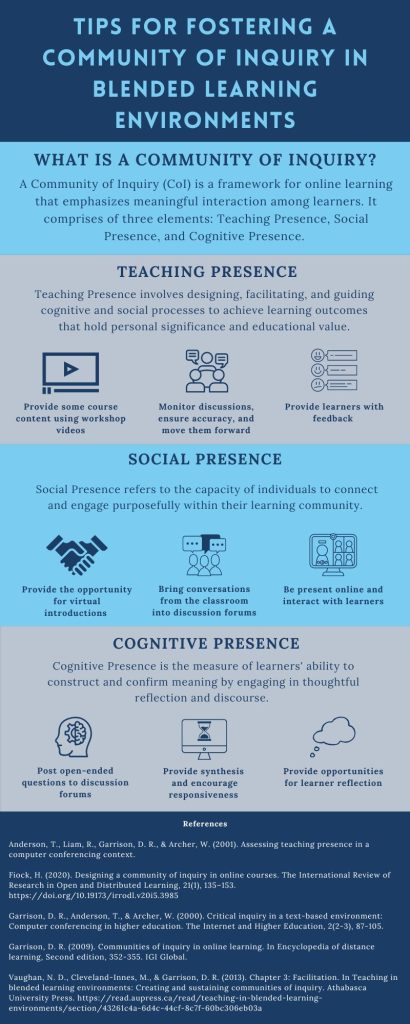
As a professor specializing in television broadcasting, I find it challenging to encourage learners to engage with each other outside of face-to-face classes. To address this challenge, I have created an infographic consisting of tips on how to foster a Community of Inquiry (CoI) in blended learning environments. A CoI is a framework for online learning that emphasizes meaningful interaction among learners and comprises three elements: Teaching Presence, Social Presence, and Cognitive Presence (Fiock, 2020).
Teaching Presence is essential for fostering a CoI, as it involves the design, facilitation, and guidance of cognitive and social processes to achieve learning outcomes that have personal significance and educational value (Anderson et al., 2001). When developing a CoI, consider creating and posting workshop videos or short lectures on your institution’s learning management system (LMS), as this approach can make learning more personalized compared to reading PowerPoint presentations and articles (Fiock, 2020). In online discussion forums, it is crucial as a facilitator to remain active and monitor the discussions, ensure the accuracy of information within the forum, and guide discussions when necessary. Lastly, ensure that learners receive constructive feedback throughout the course to help and allow them to develop further.
Social Presence is the next element that is needed to foster a CoI and it refers to the capacity of individuals to connect and engage purposefully withing their learning community (Garrison, 2009). Vaughan et al. (2013) suggest providing learners with the opportunity for virtual introductions, as this may encourage future online interaction among learners. In addition, they suggest bringing the conversations from the classroom into the discussion forums as it allows for the learning to continue outside the classroom setting. Furthermore, consider providing multiple ways for the learner and facilitator to communicate, as this interaction will help to foster trust and reduce any learning barriers.
Lastly, Cognitive Presence is the measure of a learner’s ability to construct and confirm meaning by engaging in thoughtful reflection and discourse (Garrison et al., 2000). Consider posting open-ended questions to discussion forums to help encourage critical thinking and foster discussions among learners (Vaughan et al., 2013). In addition, ensure that you provide synthesis and encourage responsiveness in online discussions. It is important when doing this not to take over discussions but to help continue them or move them along. Finally, provide opportunities for learners to reflect, as it is a key aspect of the CoI framework and has been proven to increase learners’ cognitive presence (Fiock, 2020).
References
Anderson, T., Liam, R., Garrison, D. R., & Archer, W. (2001). Assessing teaching presence in a computer conferencing context.
Fiock, H. (2020). Designing a community of inquiry in online courses. The International Review of Research in Open and Distributed Learning, 21(1), 135–153. https://doi.org/10.19173/irrodl.v20i5.3985
Garrison, D. R., Anderson, T., & Archer, W. (2000). Critical inquiry in a text-based environment: Computer conferencing in higher education. The Internet and Higher Education, 2(2-3), 87-105.
Garrison, D. R. (2009). Communities of inquiry in online learning. In Encyclopedia of distance learning, Second edition, 352-355. IGI Global.
Vaughan, N. D., Cleveland-Innes, M., & Garrison, D. R. (2013). Chapter 3: Facilitation. In Teaching in blended learning environments: Creating and sustaining communities of inquiry. Athabasca University Press. https://read.aupress.ca/read/teaching-in-blended-learning-environments/section/43261c4a-6d4c-44cf-8c7f-60bc306eb03a
September 15, 2023 at 10:50 am
Hi Giulia,
I really liked your layout design and how you explained your infographic on fostering a Community of Inquiry (CoI) in blended learning environments in television broadcasting. Which strategies do you find most impactful, and how do you address challenges in maintaining active facilitation and providing consistent feedback to learners?
Cheers,
Michal
September 15, 2023 at 3:24 pm
Thank you for exploring my infographic, Michal!
One of the strategies that I have found most impactful when teaching Broadcast-Television students is providing them with workshop videos of some of the more important camera or lighting techniques. I find this has been helpful for both retention and trouble-shooting when filming projects.
In regard to your next question, I am fortunate that I spend a lot of time with my students in class but I am also very active on our LMS, whether it is posting additional content for our learners or sending weekly reminders. Students also have assignment throughout the semester and receive feedback constantly. Thank you again for your comment!
September 20, 2023 at 7:12 pm
Great infographic, Giuila. I found your explanation for the infographic very thorough. I am also interested in how using some of the social and cognitive presence that you mentioned may assist in mitigating some of the challenges you fast in your teaching? I loved the layout of your infographic. Very clear and easy to read!